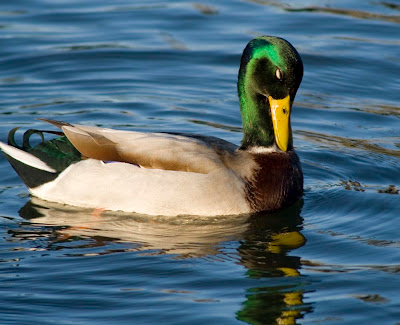 Mute swans bonding
Mute swans bondingAs the cygnets become more and more independent our mute swans reaffirm their commitment to each other with a half hearted courtship ritual. The pen was swimming downstream this morning with her two cygnets ahead of her when her mate, the cob, approaching from the other direction, spotted them and flew in to join her.
 The cob takes off to join his mate upstream
The cob takes off to join his mate upstreamThe power in his wings as he lifts from the water before full take off is quite impressive. No wonder people are sometimes afraid of swans when they get too close.
 These two hybrid ducks fly in for breakfast, bully the mallards, then return to Hurst Park
These two hybrid ducks fly in for breakfast, bully the mallards, then return to Hurst ParkThere are a large number of hybrid ducks in this area, most of which are larger than mallards and they take advantage of their size to get to the wheat before the others are allowed to feed. This morning was colder than usual and the number of ducks clamouring to be fed nearly doubled. There is definitely a pecking order and the fights that sometimes break out are vicious and vociferous. Sometimes I wonder how they don't damage themselves with the amount of wing bashing involved.
 A male tufted duck enjoys the early morning sunlight
A male tufted duck enjoys the early morning sunlightWhen we first came back from overseas, the tufted ducks were very nervous of us but now they swim towards me when I open the french windows or patio doors. They're clever enough to have worked out that when the swans are feeding there's plenty of spillage from the plank to dive for.
 A fisherman shows his sons how to gently reel in and then release a catch
A fisherman shows his sons how to gently reel in and then release a catchI was impressed by the gentle and careful way this angler reeled in his catch and then released it. There are so many people with fishing rods these days, many of whom haven't a clue how to behave responsibly, and they do untold damage to the wildlife with their carelessness and their ignorance. So often we have to rescue everything from herons and swans to moorhens and tufted ducks from the damage caused by discarded lines and hooks. If the birds become ensnared, the lines get tighter and tighter around their legs, necks or bodies. I've seen a heron drown because it had a hook in its beak and the line was caught round driftwood which dragged the herons head down to water level. As it got weaker it finally couldn't hold its head above water. I tried desperately to reach it but couldn't. I've also seen so many smaller birds lose limbs because the lines have cut off circulation. Tufted ducks and grebes dive for food and if they get caught on a hook underwater they can't resurface. If only all 'would-be' fishermen were taught how to fish responsibly!




No comments:
Post a Comment